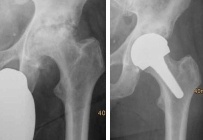Indications for the Mid Head Resection Prosthesis
- Developmental dysplasia with shortened femoral head-neck segment
- Extensive avascular necrosis of the femoral head
- Large cysts of the femoral head
- Abnormalities through Epiphyseolyses and Morbus Perthes (femoral head necrosis of children)
- Reduction of bone substance due to arthroses
- Marked bone involution through inactivity but with regression potential
 In cases of advanced arthrosis, a defect of the femoral head occurs which prevents the reliable anchoring of the resurfacing component. The titanium stem grows into the healthy part of the femoral head and neck, and is a safe base for the head component.
In cases of advanced arthrosis, a defect of the femoral head occurs which prevents the reliable anchoring of the resurfacing component. The titanium stem grows into the healthy part of the femoral head and neck, and is a safe base for the head component.
Resurfacing is only advisable when the stability of the bone and the shape of the femoral head offer sufficient support for the prosthesis. With healthy and active patients who do not meet these requirements but who can benefit from a bone conserving process, the Mid Head Resection can be an alternative to a standard prosthesis.
With this prosthesis, the fixation of the femoral component depends less on the bone of the femoral head but more on the stability of a titanium stem with bone ingrowth in the femoral neck.
Those parts of the femoral head which have been destroyed by cysts, circulatory disorders, malformations or involution due to arthrosis are removed. A titanium stem adjusted to size is implanted into the healthy part of the femoral head and neck, which is fixed by bone ingrowth (combines with the bone) and strengthens the femoral neck. In this way the implant-bone compound can withstand bending and torque forces.
Through the use of this implant, an opening of the femoral medullary cavity can often be avoided by implanting a prosthesis stem. The advantage of resurfacing is retained.
Birmingham Mid Head Resection (BMHR)
Updated December 26, 2009
